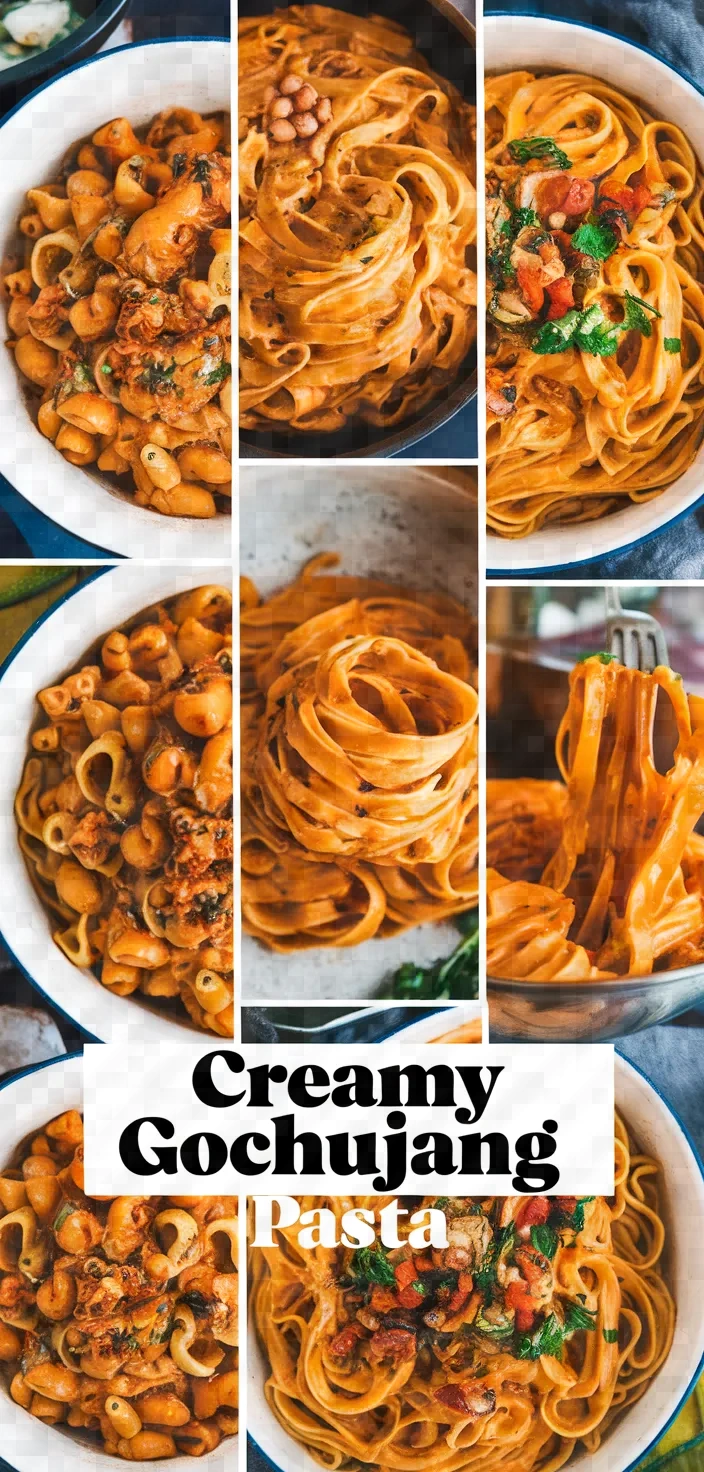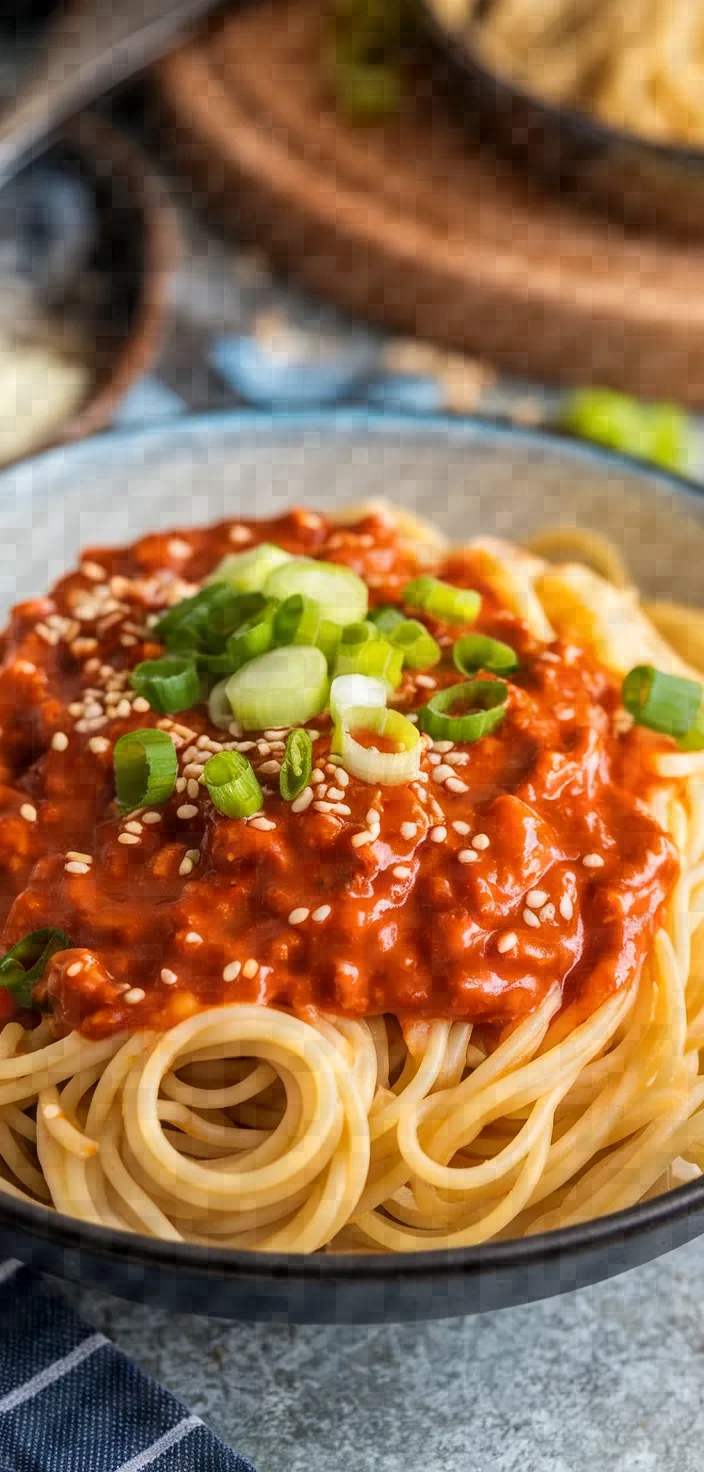Creamy Gochujang Pasta Recipe
Get ready to take your taste buds on a magical journey with this creamy gochujang pasta that perfectly balances spicy, savory, and creamy goodness—it’s like a warm hug with a side of adventure!

My love of gochujang’s transformative powers had a direct hand in creating this gochujang pasta. Gochujang, the Korean red chili paste, is fairly thick and has a nice amount of heat (though it is not overwhelmingly spicy).
It also has a lot of flavor, primarily because of the fermented soybeans in its base, and a touch of sweetness (it has a nice balance of flavors), which makes it a great ingredient for sauces. And gochujang pasta is a great way to use it.
Creamy Gochujang Pasta Recipe Ingredients

- Gochujang: A spicy-sweet Korean chili paste rich in umami and heat.
- Heavy Cream: Adds richness and creamy texture to the dish.
- Garlic: Enhances flavor, offers antioxidants, and boosts immunity.
- Soy Sauce: Deepens umami flavor with savory and salty notes.
- Parmesan Cheese: Adds savory depth and a cheesy finish.
- Honey: Provides a hint of sweetness to balance flavors.
Creamy Gochujang Pasta Recipe Ingredient Quantities
- 8 oz (225 g) spaghetti or your choice of pasta
- 2 tablespoons unsalted butter
- 4 cloves garlic, minced
- 2 tablespoons gochujang (Korean red chili paste)
- 1/2 cup (120 ml) heavy cream
- 1/4 cup (25 g) grated Parmesan cheese
- 1 tablespoon soy sauce
- 1 teaspoon honey
- 2 green onions, sliced
- Salt and pepper to taste
- 2 tablespoons sesame seeds (optional, for garnish)
How to Make this Creamy Gochujang Pasta Recipe
1. Cook the Pasta:
Fill a large pot with water, add salt, and bring it to a boil. Then, add the spaghetti and cook according to the package directions until al dente. Save 1 cup of the starch-laden water, drain the pasta, and set it aside.
2. Prepare the Sauce Base:
In a roomy frying pan over moderate heat, heat the butter until melted. Stir in the minced garlic and sauté for approximately 1-2 minutes, or until it gives off a wonderfully fragrant scent.
3. Add Gochujang:
Mix in the gochujang and cook for one more minute, letting it merge with the garlic and butter.
4. Pour in Cream
Lower the heat to low, then gradually incorporate the heavy cream with the gochujang mixture, stirring steadily.
5. Incorporate Cheese and Seasonings:
Mix in the grated Parmesan cheese, soy sauce, and honey until the cheese is melted and the sauce is smooth.
6. Adjust Consistency:
Should the sauce prove to be too thick, gradually add a bit of the reserved pasta water; stir and see if this brings you to the desired consistency.
7. Combine with Pasta:
Incorporate the cooked pasta into the skillet, and toss until the noodles are evenly coated with the creamy sauce and jointed with the gochujang.
8. Season to Taste:
Pasta seasoning with salt and pepper to taste. Remember that gochujang and soy sauce are added, both of which are salty.
9. Complete with green onions: Stir in the majority of the sliced green onions, reserving a handful for garnish.
10. Serve and Garnish:
Toss the creamy gochujang pasta onto serving plates and top with the remaining green onions and sesame seeds, if using. Serve immediate.
Creamy Gochujang Pasta Recipe Equipment Needed
1. Large pot
2. Slotted spoon or regular spoon
3. Colander or sieve
4. Large frying pan or skillet
5. Measuring cups and spoons
6. Knife
7. Cutting board
8. Wooden spoon or spatula
9. Grater (for Parmesan cheese)
10. Tongs or pasta fork for mixing
11. Ladle (for reserving pasta water)
FAQ
- Q: Can I use a different type of pasta?A: Yes, you can replace the spaghetti with any pasta shape you like, such as fettuccine, penne, or linguine.
- Q: Is this dish very spicy?The spice level is moderate, thanks to the gochujang. But if you wish to tone it down a bit, just use a little less of the paste.
- Q: Can I make this dish vegetarian?Certainly! Just verify that your Parmesan is suitable for vegetarians, and savor a rendition free of meat.
- Q: What can I use instead of heavy cream?A: Coconut cream can be used to replace heavy cream when you need a dairy-free alternative. Just know that it may slightly change the flavor profile of your recipe.
- Q: How do I store leftovers?A: Any uneaten pasta should be placed in an airtight container and put into the refrigerator, where it will keep for up to 3 days. To serve it after the fact, reheat it gently on the stovetop or in the microwave.
- Q: Can I add vegetables or protein to this dish?A: Yes, you can certainly add cooked chicken, shrimp, or vegetables such as bell peppers or spinach to make it a more substantial meal. Feel free!
- Q: Is gochujang gluten-free?A: Certain brands of gochujang may contain wheat. Check the label if you need your gochujang to be wheat-free and choose a brand that makes this clear.
Creamy Gochujang Pasta Recipe Substitutions and Variations
Use fettuccine, linguine, or a gluten-free pasta to provide a different texture or meet a dietary preference for spaghetti.
To replace gochujang, you can use sriracha sauce or a mixture of red chili paste and a touch of sugar. The flavor will not be exactly the same, but it will work in a similar way.
For heavy cream: use half-and-half or coconut milk for a lighter or dairy-free option.
To create a vegan version of Parmesan cheese, substitute with either Pecorino Romano or nutritional yeast.
For soy sauce, you can use tamari for a gluten-free substitution or coconut aminos for a soy-free alternative.
Pro Tips
1. Boost Flavor with Toasted Sesame Oil Before serving, drizzle a small amount of toasted sesame oil over the finished dish. This will add a rich, nutty aroma and enhance the overall flavor profile, complementing the gochujang nicely.
2. Balance Heat and Sweetness If you find the gochujang too spicy, or if you prefer a slightly sweeter dish, adjust the amount of honey to your taste. Start with the recommended amount and add more gradually until you reach your desired balance.
3. Use Freshly Grated Parmesan For a creamier and more flavorful sauce, grate fresh Parmesan cheese directly into the dish rather than using pre-grated cheese. The freshness and texture of the cheese will make a noticeable difference.
4. Get Creative with Protein Consider adding protein such as grilled chicken, shrimp, or tofu to the recipe. Cook the protein separately and mix it in with the pasta just before serving for a more substantial meal.
5. Enhance with Vegetables Incorporate vegetables like sautéed mushrooms, bell peppers, or spinach into the pasta for added nutrition and texture. These can be cooked in the same pan after the garlic step and before adding the gochujang to make it a more balanced dish.

Creamy Gochujang Pasta Recipe
My favorite Creamy Gochujang Pasta Recipe
Equipment Needed:
1. Large pot
2. Slotted spoon or regular spoon
3. Colander or sieve
4. Large frying pan or skillet
5. Measuring cups and spoons
6. Knife
7. Cutting board
8. Wooden spoon or spatula
9. Grater (for Parmesan cheese)
10. Tongs or pasta fork for mixing
11. Ladle (for reserving pasta water)
Ingredients:
- 8 oz (225 g) spaghetti or your choice of pasta
- 2 tablespoons unsalted butter
- 4 cloves garlic, minced
- 2 tablespoons gochujang (Korean red chili paste)
- 1/2 cup (120 ml) heavy cream
- 1/4 cup (25 g) grated Parmesan cheese
- 1 tablespoon soy sauce
- 1 teaspoon honey
- 2 green onions, sliced
- Salt and pepper to taste
- 2 tablespoons sesame seeds (optional, for garnish)
Instructions:
1. Cook the Pasta:
Fill a large pot with water, add salt, and bring it to a boil. Then, add the spaghetti and cook according to the package directions until al dente. Save 1 cup of the starch-laden water, drain the pasta, and set it aside.
2. Prepare the Sauce Base:
In a roomy frying pan over moderate heat, heat the butter until melted. Stir in the minced garlic and sauté for approximately 1-2 minutes, or until it gives off a wonderfully fragrant scent.
3. Add Gochujang:
Mix in the gochujang and cook for one more minute, letting it merge with the garlic and butter.
4. Pour in Cream
Lower the heat to low, then gradually incorporate the heavy cream with the gochujang mixture, stirring steadily.
5. Incorporate Cheese and Seasonings:
Mix in the grated Parmesan cheese, soy sauce, and honey until the cheese is melted and the sauce is smooth.
6. Adjust Consistency:
Should the sauce prove to be too thick, gradually add a bit of the reserved pasta water; stir and see if this brings you to the desired consistency.
7. Combine with Pasta:
Incorporate the cooked pasta into the skillet, and toss until the noodles are evenly coated with the creamy sauce and jointed with the gochujang.
8. Season to Taste:
Pasta seasoning with salt and pepper to taste. Remember that gochujang and soy sauce are added, both of which are salty.
9. Complete with green onions: Stir in the majority of the sliced green onions, reserving a handful for garnish.
10. Serve and Garnish:
Toss the creamy gochujang pasta onto serving plates and top with the remaining green onions and sesame seeds, if using. Serve immediate.
